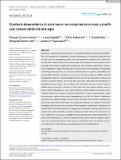Files in this item
Context-dependency in carnivore co-occurrence across a multi-use conservation landscape
Item metadata
| dc.contributor.author | Curveira-Santos, Gonçalo | |
| dc.contributor.author | Gigliotti, Laura | |
| dc.contributor.author | Sutherland, Chris | |
| dc.contributor.author | Rato, Daniela | |
| dc.contributor.author | Santos-Reis, Margarida | |
| dc.contributor.author | Swanepoel, Lourens H. | |
| dc.date.accessioned | 2022-08-30T16:30:11Z | |
| dc.date.available | 2022-08-30T16:30:11Z | |
| dc.date.issued | 2022-08 | |
| dc.identifier | 281095573 | |
| dc.identifier | 8100d071-356e-4a24-9aa6-a2916072b746 | |
| dc.identifier | 85136955777 | |
| dc.identifier | 000847231400001 | |
| dc.identifier.citation | Curveira-Santos , G , Gigliotti , L , Sutherland , C , Rato , D , Santos-Reis , M & Swanepoel , L H 2022 , ' Context-dependency in carnivore co-occurrence across a multi-use conservation landscape ' , Ecology and Evolution , vol. 12 , no. 8 , e9239 . https://doi.org/10.1002/ece3.9239 | en |
| dc.identifier.issn | 2045-7758 | |
| dc.identifier.other | RIS: urn:361BA1ACF401702CB5416356CAF36026 | |
| dc.identifier.other | ORCID: /0000-0003-2073-1751/work/118412158 | |
| dc.identifier.uri | https://hdl.handle.net/10023/25918 | |
| dc.description | This research was funded by South Africa's National Research Foundation (UID: 107099 and 115040), African Institute for Conservation Ecology, National Geographic Society (EC-314R-18) and Wild Tomorrow Fund. G.C.-S. and M.S.-R. were funded by Fundacão para a Ciência e a Tecnologia in the frame of a doctoral grant (PD/BD/114037/2015) and the research unit (UID/BIA/00329/2019), respectively. | en |
| dc.description.abstract | Carnivore intraguild dynamics depend on a complex interplay of environmental affinities and interspecific interactions. Context-dependency is commonly expected with varying suites of interacting species and environmental conditions but seldom empirically described. In South Africa, decentralized approaches to conservation and the resulting multi-tenure conservation landscapes have markedly altered the environmental stage that shapes the structure of local carnivore assemblages. We explored assemblage-wide patterns of carnivore spatial (residual occupancy probability) and temporal (diel activity overlap) co-occurrence across three adjacent wildlife-oriented management contexts?a provincial protected area, a private ecotourism reserve, and commercial game ranches. We found that carnivores were generally distributed independently across space, but existing spatial dependencies were context-specific. Spatial overlap was most common in the protected area, where species occur at higher relative abundances, and in game ranches, where predator persecution presumably narrows the scope for spatial asymmetries. In the private reserve, spatial co-occurrence patterns were more heterogeneous but did not follow a dominance hierarchy associated with higher apex predator densities. Pair-specific variability suggests that subordinate carnivores may alternate between pre-emptive behavioral strategies and fine-scale co-occurrence with dominant competitors. Consistency in species-pairs diel activity asynchrony suggested that temporal overlap patterns in our study areas mostly depend on species' endogenous clock rather than the local context. Collectively, our research highlights the complexity and context-dependency of guild-level implications of current management and conservation paradigms; specifically, the unheeded potential for interventions to influence the local network of carnivore interactions with unknown population-level and cascading effects. | |
| dc.format.extent | 17 | |
| dc.format.extent | 3601189 | |
| dc.language.iso | eng | |
| dc.relation.ispartof | Ecology and Evolution | en |
| dc.subject | Camera trap | en |
| dc.subject | Conservation management | en |
| dc.subject | Co-occupancy | en |
| dc.subject | Interspecific interactions | en |
| dc.subject | Temporal overlap | en |
| dc.subject | QH301 Biology | en |
| dc.subject | DAS | en |
| dc.subject | SDG 8 - Decent Work and Economic Growth | en |
| dc.subject.lcc | QH301 | en |
| dc.title | Context-dependency in carnivore co-occurrence across a multi-use conservation landscape | en |
| dc.type | Journal article | en |
| dc.contributor.institution | University of St Andrews. Statistics | en |
| dc.contributor.institution | University of St Andrews. Centre for Research into Ecological & Environmental Modelling | en |
| dc.identifier.doi | 10.1002/ece3.9239 | |
| dc.description.status | Peer reviewed | en |
This item appears in the following Collection(s)
Items in the St Andrews Research Repository are protected by copyright, with all rights reserved, unless otherwise indicated.

